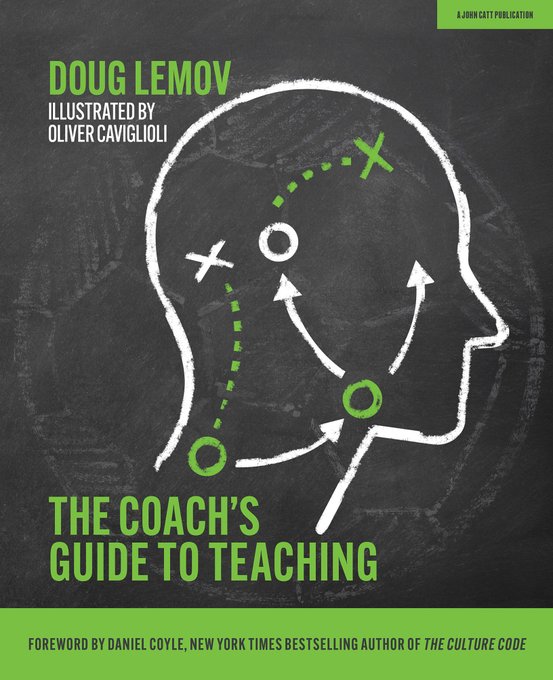01.24.21The Coach’s Guide to Teaching: What’s Inside?

My latest book, The Coach’s Guide to Teaching hit the shelves in December. Yes, it’s about coaching athletes. I tried to take what I know about teaching, combine it with what cognitive science says about learning shoot it through the lens of the game I love: soccer/football. Hope that doesn’t sound narrow; It’s for coaches but I think a lot of people in the broader education sector might enjoy it.
Writing it was a journey of more than five years’ duration, during which time I spend perhaps 20 days a year working with coaches in professional sports franchises and national federations. At first I kept my life working with coaches separate from my day job training and studying teachers but the book wouldn’t stay in its lane. Every time I watched video of a classroom or visited a school I was reminded of some issue raised in my conversation with coaches.
Anyway, a fair number of people have asked ‘What’s it about?’ it so here’s a quick summary of what’s inside it and links to a few excerpts:
WHAT’S INSIDE
This book consists of six chapters. The first, “The Ability to Decide,” is about decision-making, which I call the most important proficiency of all. It focuses heavily on the under-acknowledged role of perception. Expertise is in the eyes. You cannot make the right decisions unless your eyes are in the right place and know what to look for. How then do we develop athletes’ eyes and the more advanced cognitive processes they support?
Chapter 2 is about planning and session design, both within a session and within a unit. Planning units of learning (of four or six weeks’ duration, say) is far less common than planning single sessions, but at least as important because long-term memory can only be built over time. As I hope to show, the role of long-term memory is vastly underappreciated by most educators—coaches included. Consider this: you have forgotten almost everything you’ve learned in your life. Athletes are no different. How do you know they will remember what you’ve taught them when they need it?
Chapter 3 is about giving feedback, which is perhaps the single coaching action we do most. That it is so familiar to us makes it easy for us to rely on old and untested habits. We give feedback the way we do because…well, who knows. Perhaps because Coach Carlton gave us feedback that way 25 years ago. And why did he do it that way? Well, Chapter 3 is your chance to think about some of the decisions you make about feedback. The science of
working memory and attention will play a key role.
Chapter 4 is about John Wooden’s adage that teaching is knowing the difference between “I taught it” and ”They learned it.” It’s among the hardest things to do in teaching and the science of perception will come back to play a key role.
Chapter 5 is about building culture. Culture is often the thing we remember best from our own sporting days, and its messages are what we carry with us longest, perhaps because our individual behaviors have evolved to be extremely responsive to group culture. In the end, you can get a lot wrong if you get culture right.
Excerpt:
The sixth chapter is about long-term growth and development—your players’ and your own. I’ll discuss, among other things, how to balance long-term learning goals with the short-term task of winning, how gameday
coaching is different from coaching in practice, how to make good decisions when selecting talent, and how to make sure that you grow and develop as much as you can in your own coaching journey.
IS IT A GENERAL COACHING BOOK OR A SOCCER
COACHING BOOK?
The book is intended to offer lessons and guidance that are applicable to coaches of any sporting endeavor. But because I take domain knowledge seriously and have immense respect for how much coaches know about their chosen sport, I’ve chosen to write through the lens of the sport I know
best: soccer. My hope is that coaches of other sports will be able adapt and apply the lessons to their own contexts without my giving direct examples from them. I do this because I am reluctant to try to provide examples from
games I do not sufficiently understand. That said, while my examples are drawn heavily from soccer, you’ll notice throughout the book that I’ve asked top-tier coaches from other sports or with different perspectives to provide reflections and context in sidebars.
They include, in addition to several soccer coaches:
- Jeff Albert, Hitting Coach, St. Louis Cardinals
- Sefu Bernard, Director of Player Development, Washington Mystics
- Joe Mazzulla, Assistant Coach, Boston Celtics
- Dan McFarland, Head Coach, Ulster Rugby
- Dave Love, consulting shooting coach for several NBA teams
I asked them to reflect on how they do or might adapt and apply the ideas in this book to their own sports. I hope this will provide support and insight for coaches who seek to take some of the concepts in the book and apply them to other sports or other settings.
Here’s an example:
